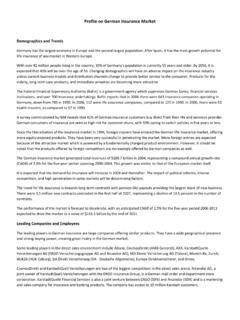Transcription of SME’s LIFE CYCLE – STEPS to FAILURE or SUCCESS?
1 SME's life CYCLE STEPS to FAILURE or success ? Noel Jones1. Abstract The body of literature on SMEs suggest that all SMEs seem to go through different life cycles, and while the terms used by different authors may vary, the events that govern them are all too familiar to the founders and managers involved. While each SME may seek to grow from the start it will inevitably meet new challenges and crises over time that must be addressed effectively if the business is to survive and prosper. This author believes that these crises are characterised as Plateaus' that must be carefully managed in order for the business to be ready for its next growth period. If neglected and the business tries to continue business as usual' during a crisis it will collapse in FAILURE . As so many have done in the past and why the average life span of many SMEs is only five years. Moya K. Mason (2009) points out that: The Small Business Administration (SBA) keeps the stats on business failures and claims that more than half of new businesses will disappear in the first five years.
2 According to an August 2009 Business Daily Article - Poor practices lead to high SME mortality: poor management and a shortage of funds have been identified as the main cause of start-up deaths globally. It is recommended that training be provided for all SME entrepreneurs to prepare them for the road ahead and the challenges and crisis that they will inevitable meet along the way. This Paper provides a brief look at a typical SME's life CYCLE in terms of both its Growth Phases and the subsequent crises Plateaus' it must manage along the way in order to survive and prosper, and be ready for the next growth Phase. Key words: Small Medium Enterprises (SMEs), Corporate/company life cycles. Introduction States, for example. As pointed out by Mason Now with the financial crisis still wreaking (2009), the Small Business Administration havoc on the world and many large (SBA) keeps the stats on business failures and corporations and public sector organizations claims that more than half of new businesses reducing their staff numbers, many aspiring will disappear in the first five years.
3 And, as entrepreneurs, suddenly finding themselves out an August 2009 Business Daily article, of work, are striving to make their dreams ominously entitled Poor practices lead to high come true and seeking to start their own SME mortality,' indicates, business FAILURE at business. Most such businesses are Small to an early stage of a company's existence is a Medium Sized Enterprises, businesses worldwide phenomenon: poor management employing fewer than 250 people, commonly and a shortage of funds have been identified as referred to as SMEs2. the main cause of start-up deaths globally. The history of SMEs is one where many Experts say a majority of small businesses fold have gone but few have succeeded. The up after an average of 18 months due to FAILURE average lifecycle of many SMEs is in the to stand up to competition. About 80% of start- region of five years or less. Take the United ups are expected to fail the FAILURE rate is not localized, even in advanced economies the mortality rate is just as high.
4 Harvard Professor Mukti Khaire3 is equally blunt and 1. Noel Jones, has been a Visiting Professor at categorical in his assessment of SMEs' life Assumption University, Graduate School of Business, expectancy: the track record is well known since 2000. He was a Visiting Professor at the Joint and sobering for any entrepreneur: 90 per cent Vienna Institute, Austria from 1993 to 2004. A former staff member at both the IMF and WB HQs in of all new ventures fail as start-ups often lack Washington between 1987 and 1997, he continues as a vital resources, must compete against consultant to many WB Projects established companies, and have little or no 3. track record with which to woo customers and conclusion that organizations seem to move investors. Figures invariably point to a high through five distinguishable types of growth mortality rate. each phase contain[ing] a relatively calm And figures are even more baffling when period of growth that ends with a management one takes into consideration the fact that many crisis.
5 The five phases and crises which who fail learn invaluable lessons for future Greiner identified are: ventures that can thus increase their chances of (1) growth through creativity, followed by success , a view which this author endorses. For, a crisis of leadership;. as Thomas Edison once said about his many (2) growth through direction, followed by a failures en route to inventing the electric light crisis of autonomy;. bulb: I will not say I failed a 1,000 times, I (3) growth through delegation, followed by will say that I have discovered that there are a a crisis of control;. 1,000 ways that Cause FAILURE . Moreover, as (4) growth through coordination, followed Albert Einstein once remarked: If someone by a crisis of red tape;. feels that they had never made a mistake in (5) growth through collaboration; followed their life , then, it means that they have never by a crisis of psychological saturation tried a new thing in their life .
6 Still, while among employees. This crisis can be solved making mistakes is an integral part of the by new structures and programs that allow learning process, it does not of itself explain employees to periodically rest, reflect, and the high rate of attrition. Which begs the revitalize themselves.. question of why so many defunct SMEs? Others have followed his work and One way to account for this high level of expanded on it, and in time developed a rich FAILURE is to consider company life cycles, an literature on company life cycles. One such approach which this paper will follow. This scholar to whom Kees van Montford (2006). author has identified four key Phases to all refers in his landmark work dealing with the SME Start ups. However, it is also this life CYCLE characteristics of small professional author's belief that, as each of these four service firms are Lavoie and Culbert (1978). Phases comes to an end, there are important who, as he put it, stressed the human factor in decisions to be made.
7 This author calls these organizational development in their review of defining moments, which represent transitional a series of different theories. To be effective, stages from one Phase to another, Plateau organizational development must be tied to Stages'. Each of the four stages will therefore progressively mature reasoning processes that consist of a Phase and a Plateau. characterize managers working in increasingly After briefly reviewing the history of higher stages of the organization's evolution. company life cycles, upon which these four Valid organizational change and development Phases are based, and considering whom these basically addresses the problem of getting potential entrepreneurs are, each Phase - and managers and their employees to upgrade the Plateau - will thus be explored at length. A values and logic underlying their patterns of whole life CYCLE pattern will then emerge decision-making.. making it abundantly clear that training should Another significant contributor to this field be provided for all SME entrepreneurs to is Adizes (1979) who argued, among others, prepare them for the many challenges ahead.
8 That the attitudes and style of an organization's managers may provide a means 1. A Brief History of Company life Cycles for ensuring a long and effective life for an One of the earliest writers on company life organization. Adizes identified 10 life Stages CYCLE growth was Greiner (1972) who provided in the corporate life CYCLE of an organization. the foundational work on the theory of a They include: company's development as evolution and 1. courtship (the initial development or revolution. Based on his theoretical review of creation of the proposition/ model/. developing organizations he came up with the business/ formation/etc);. 4. 2. infancy (after launch - start of active of development may well be different from the trading); criteria used to evaluate success during 3. go-go (frantic energetic early growth and another developmental stage.. sometimes chaos); Applying the findings of Greiner to the 4. adolescence (still developing but more small entrepreneurial business situation, established and defined); Churchill and Lewis (1983) developed a model 5.
9 Prime (the business or organization at its that has become a classic. Starting from the fittest, healthiest and most competitive, position that many of the traditional models are popular and profitable); not suitable for small entrepreneurial 6. stability (still effective, popular, can still businesses because not all such businesses be very profitable, but beginning to lose must go through the typical stages of leading edge - vulnerability creeping in development or risk FAILURE , they argued that maybe); many traditional models do not pay enough 7. aristocracy (strong by virtue of market attention to the entrepreneur him/herself, to presence and consolidated accumulated why they started the business in the first successes, but slow and unexciting, instance, and to what happened in its early definitely losing market share to stages of development and growth. They also competitors and new technologies, trends, showed that for the small entrepreneurial etc); business each stage is characterized by size, 8.
10 Recrimination (doubts, problems, threats diversity, complexity, and the following and internal issues overshadow the management factors: managerial style;. original purposes); organizational structure; extent of formal 9. bureaucracy (inward-focused systems; major strategic goals; and owner administration, cumbersome, seeking exit involvement.. or divestment, many operating and Following Greiner's seminal work, Scott marketing challenges); and Bruce (1987) came up with a similar five- 10. death (closure, sell-off, bankruptcy, phase model, classifying those stages of bought for asset value or customer-base development as inception, survival, growth, only) expansion, and maturity. Like Greiner, they too stressed that a crisis of some kind comes before each stage of development or growth. Also of great import is the work of Quinn This model is somewhat similar to the four- and Cameron (1983) who examined many phase model developed by this author as models, which they then combined and described below, where each crisis stage is summarized into one theoretical model.








